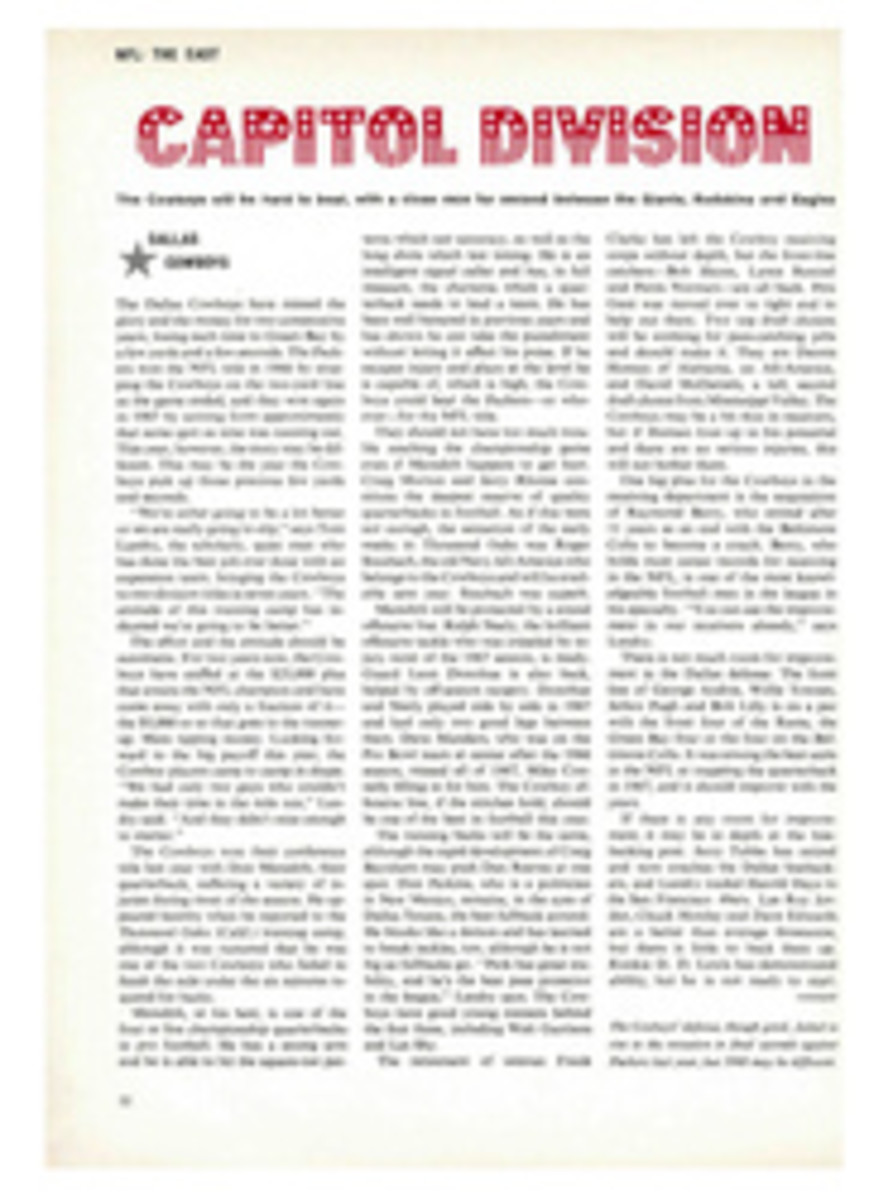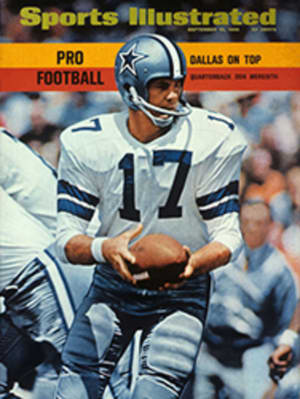
ARTHUR ALL THE WAY
By the time the first U.S. Open Tennis tournament had come down to its final confrontation—the battle for the men's singles title—the bodies of the world's best professionals were strewn all over Forest Hills. Rod Laver was long gone, beaten in the fourth round. So was Roy Emerson. Ken Rosewall was out, as were John Newcombe, Tony Roche and the rest of the Handsome Nine. What was left were two amateurs, more or less. One of them was Tom Okker, a 24-year-old Dutchman who had wiped out three pros on his way to the final. As a registered player—that is, an amateur who is allowed to collect prize money in certain tournaments—Okker had already pocketed the $14,000 first prize. Some amateur. His opponent was Arthur Ashe, the nation's top player, amateur or pro. Ashe had also beaten three pros to reach the final and had earned $15 a day doing it.
It was a memorable final, a case of attack and counterattack. Ashe won a long first set 14-12, but Okker bounced back in the second 7-5. When Ashe took the third 6-3 he seemed a winner, but again Okker rallied, winning the fourth set 6-3. But in the final set Ashe's power proved decisive as he ran out the match 6-3. For Ashe, it was his second straight major victory, coming on top of the U.S. amateur, and it proved that he had finally reached the top, just as everyone thought he someday would.
It was the most exciting Forest Hills in a long time. Because it was an open tournament, there were past champions on every court, a Hall of Fame on parade. Strolling the grounds were 20 players who among them had won 52 Wimbledon and Forest Hills titles. Last year's men's singles final between John Newcombe and Clark Graebner (when Forest Hills was an amateur tournament) was replayed in the quarterfinals this year, an indication of the strength of the draw. Pancho Gonzalez, returning to the scene of his first major triumph 20 years before, gave the galleries the best show of the tournament. And Billie Jean King, trying to match her Wimbledon victory, was upset by England's Virginia Wade, another money-making ($6,000) amateur.
Naturally, the tournament had its flaws. The Open brought in the pros and with them cigarette ads inside the old stadium, $8 tickets and balls bottled by Macy's (though made by Slazenger). Three groups had a hand in the tournament—the USLTA, which sponsored and ran it; the West Side Tennis Club, which played host; and Madison Square Garden Attractions, Inc., which organized it, or tried to. When three separate groups try to run anything, you have problems. For instance, the Open was rained out just one day, yet the men's singles finished a day late. The grass courts were war-torn, but that's standard. The Macy's balls were heavy, which may account for the fact that so many pros had so much trouble. The pros play in their own little world—mostly indoors—and seem less adaptable to change than the amateurs.
Lastly, the draw was rigged—that's the right word—so that the touring pros, who are members of groups run by George MacCall and Al Hill Jr., would not meet until they mathematically had to, that being the fourth round. A small point, perhaps, but a rigged draw is still a rigged draw. (There was a suspicion that the women's draw was similarly manipulated, since the four professional players—Mrs. King, Ann Jones, Rosemary Casals and Francoise Durr, only two of whom were seeded—conveniently wound up in separate quarters.)
However, none of these flaws succeeded in spoiling the tournament. If nothing else, the former champions made Forest Hills a connoisseur's delight. Over on the grandstand court one could watch Don Budge and Frank Parker reviving the past in a seniors doubles match against Bobby Riggs and Pancho Segura, as Jack Kramer (at Forest Hills as a TV commentator) leaned on an adjoining green fence, watching. Several courts away, Vic Seixas and Tony Trabert were teamed for the first time in 13 years, playing in the men's doubles and reaching double match point against Okker and Marty Reissen before losing. Nearby, Bill Talbert was playing doubles against Gardnar Mulloy, while in the women's doubles Pauline Betz Addie and Gussie Moran were testing their old skills against a younger team.
But of all the old champions at Forest Hills last week no one attracted more attention, or produced more excitement, than Gonzalez, who came to the tournament as keyed-up as anybody ("I nearly threw up," he said after one match), but without any delusions about his age, 40, or how long he could last. After an easy victory over Colin Stubs of Australia and a surprising 6-4, 6-4, 6-4 win over Mal Anderson that put him into the fourth round against second-seeded Tony Roche, Gonzalez said, "I'm realistic. Three or four matches is about all I can take. To win seven is a big jump. If I beat Roche I would have to sit down and say I've gone about as far as I expected to."
Before the Roche match Gonzalez taped the fingertips of his right hand, not unlike a prizefighter, and walked onto the stadium court to the cheers and applause of a crowd that might have booed him 10 years ago. "It's embarrassing," he said. He went through his nervous rituals, sweeping his hand through his graying black hair, rubbing the sweat from his eyes and hitching up his shirt at the shoulder before every point—and also played excellent tennis.
In his prime Gonzalez did not often need a lot of finesse. "I always had that big serve," he said, "and as a match got longer I got stronger than my opponent. I could count on it." But now he cannot afford long matches, and must go for the service break at every opportunity. Against Roche he did it by chipping low, angled returns of service to force Roche to volley up. Roche made numerous errors off these shots, and when he didn't Gonzalez often set up the point with a lob or quickly moved in to the net to volley the ball past him. It was a magnificent display of tactics. Gonzalez won 8-6, 6-4, 6-2, and thus went into the quarterfinals against Okker.
Unfortunately, Okker followed the day after Roche, and as the first set wore on without a conclusion Gonzalez's chances diminished, although in the 26th game he held service at love by reeling off three clean service aces and a near ace. At 14-14 Gonzalez broke Okker, then held to win the first set 16-14. Okker took the second, 6-3, and again in the third they played even until Okker got the crucial break in the 11th game to lead 6-5. Gonzalez played a desperate game and broke Okker right back, but Okker broke Gonzalez again in the 17th game and held for the set 10-8.
In the final set Gonzalez dropped four points on his service in the first game and Okker ran out the match 6-3. Gonzalez was out of the tournament and very tired, but the day before, slouched in a chair after defeating Roche, a towel tossed around his shoulders, he grinned, looking for all the world like the bright-eyed kid who had come out of the Mexican district of Los Angeles to win the U.S. title in 1948 at the age of 20 and to defend it a year later against Ted Schroeder in one of the classic Forest Hills finals. That one moment was enough. As Okker said, "He's still a good player."
With Gonzalez out, attention was focused on the rest of the tournament. Laver had lost to Cliff Drysdale by 4-6, 6-4, 3-6, 6-1, 6-1, and in the final two sets he barely made a fight of it. Since July 20, when he had been beaten by Gonzalez in the finals of a Los Angeles tournament, Laver had played just two tournament matches before Forest Hills. He rested 2½ weeks to nurse an injured wrist, then lost to Fred Stolle in Binghamton, N.Y. and Anderson in Fort Worth. "If you don't go into a match with confidence, you're through," he said. "Even when I was ahead two sets to one, I felt shaky. I need to play every day, not just practice, and two matches aren't enough. I don't mean to sound like I'm making excuses. I'm not. Cliff was better today. But I guess you've got to have excuses, don't you? If you don't feel you're better than the other fellow you might as well shake hands with him before the match starts."
Laver's upset, coupled with Roche's loss, meant that the two top-seeded players had been eliminated before the quarters at Forest Hills for the first time, and, more than that, the way had been opened for a lot of pretenders to the title. In the upper half, Laver's half, the two American Davis Cuppers, Ashe and Graebner, worked their way to the semifinals. Ashe, who had not dropped a singles match in more than seven weeks (in the process winning two major tournaments, the Pennsylvania Grass Court Championships and the U.S. amateur title, four Davis Cup matches and one Army tournament), defeated both Roy Emerson and Laver's conqueror, Drysdale, before ousting Graebner in four sets.
In the bottom half Okker made the semis, of course, by defeating Gonzalez. Rosewall was able to sleep through the first five rounds. He lost only 16 games in his first three matches, somehow was extended to four sets against Ron Holmberg in the fourth, then played Dennis Ralston, the best American professional, in the quarterfinals. That could have been a severe test for Rosewall, but in a third-round match against Joaquin Loyo-Mayo of Mexico, Ralston had pulled a stomach muscle, then aggravated it further while defeating Nikki Pilic, and had seriously considered defaulting to Rosewall rather than risk an injury that might knock him out of action for several weeks. "I don't want to have to serve underhand," he said.
Before the match he had a shot of novocain, which did little good. He tapped the ball into play, could not follow his service to the net and while attempting to protect his stomach injured his back. Rosewall won 6-2, 6-2, 6-3.
In the semifinals Ashe and Graebner were merely playing for a spot in the finals, and perhaps to increase their bargaining position with the professionals this coming winter. (The USLTA does not yet provide for registered players from its own association, but an informal vote of its regional delegates indicated that it probably soon will.) The $14,000 naturally added a little something to the Okker-Rosewall semi, but the match really didn't need anything extra. The score was 8-6, 6-4, 6-8, 6-1 and just as easily could have gone in Rosewall's favor. In both of the first two sets he was up a service break. In the first, however, his service betrayed him—he double-faulted on set point—and in the second Okker's quickness and lightning passing shots pulled the Dutchman back even and then on to victory and the finals.
Thus it was that the last of the professionals was eliminated from the first U.S. Open Tennis Championship, the very tournament those same pros had been hoping to play in for years. It was both ironic and significant that the amateurs should win all the glory—and most of the money, too.
TWO PHOTOS
The finals brought together two vividly contrasting styles of play: the speed and agility of Okker (left) against the devastating power of Ashe.
FIVE PHOTOS
Though his jet hair is graying, Pancho Gonzalez, returning to the scene of his first major triumph 20 years ago, still had a lean and hungry look.

